Jackie Kennedy would have been shocked
Trump paves paradise and puts up a ballroom
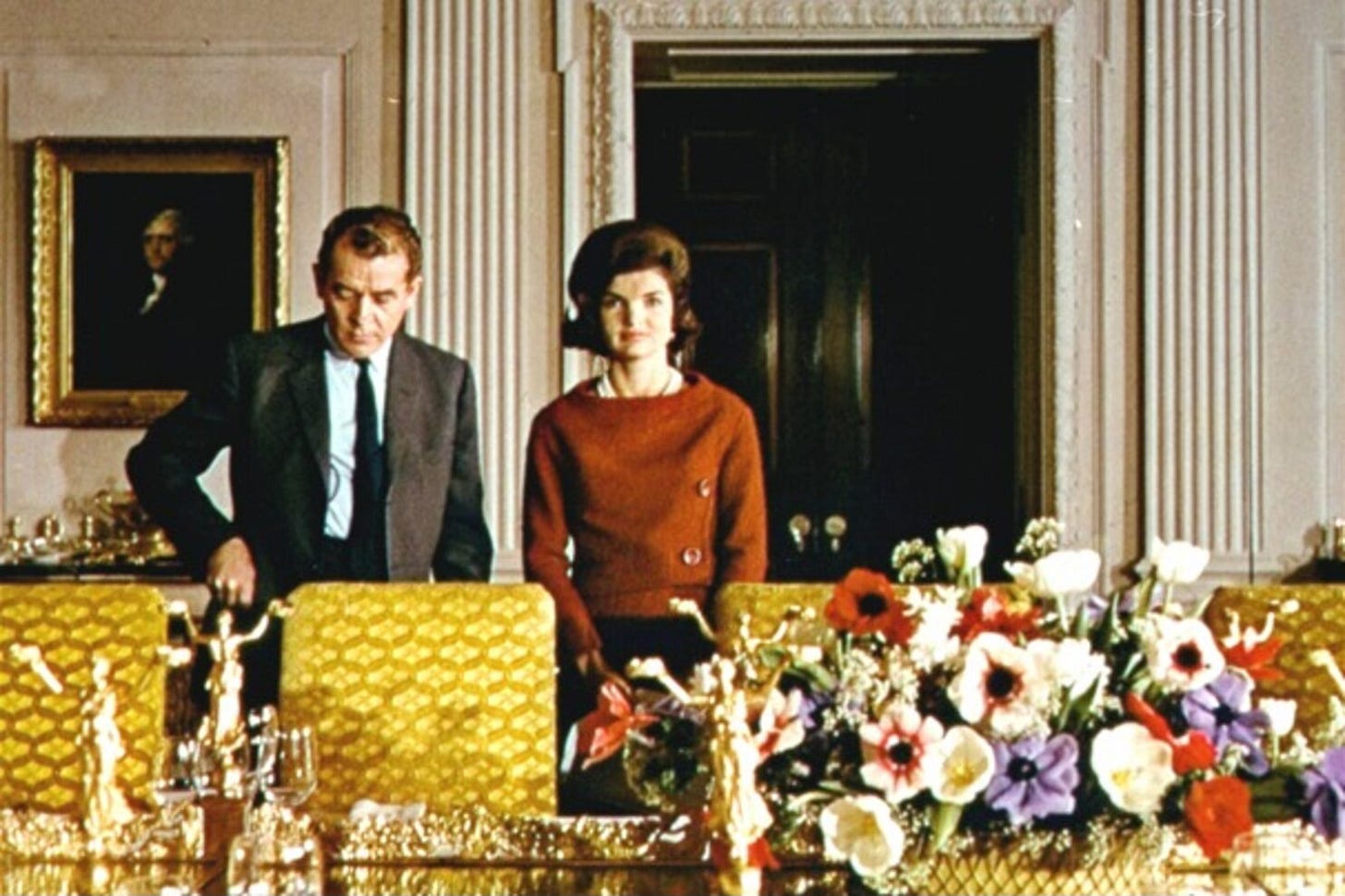
On Valentine’s Day in 1962, Jacqueline Bouvier Kennedy gave the world a televised tour of her home, the White House. Eighty million people saw the First Lady, in pearls and a bouffant hairdo, describe the history of the building and show off the renovations she was making to it.
In the style of the times, the CBS broadcast wasn’t titled as a tour with Jacqueline Kennedy but rather: “A Tour of the White House With Mrs. John F. Kennedy”
One striking fact emerged early in the program — Jackie Kennedy had been disappointed when she and her family moved into the White House. In fact, she had lamented the building’s condition even when she toured it as a child.
“It just seemed to me such a shame when we came here to find hardly anything of the past in the house. Hardly anything before 1902,” she said. “I know when we went to Colombia, the presidential palace there has all the history of that country in it. Where Simón Bolivar was, every piece of furniture in it has some link with the past. I thought the White House should be like that.”
The First Lady resolved to make changes. She began searching government storerooms for furniture and artifacts that would truly represent the history of the White House and soliciting classic American paintings from donors.
Charles Collingwood, the CBS journalist who hosted the show with Jackie Kennedy, asked her, somewhat condescendingly, “Well, now can you make these changes according to your own personal tastes and desires?”
“Well, no,” she replied. “I have a committee which has museum experts and government people and private citizens on it.”
Jacqueline Kennedy did more than any other First Lady to turn the White House into a true national monument. She created the fine arts committee to oversee the White House renovations, appointed the first White House curator, founded the White House Historical Association, and published the first White House Guidebook, which helped to fund the association.
“Kennedy spearheaded efforts to make the White House a museum, protected by Congress, and renovated many rooms. She expanded the White House Collection, searching for historic pieces from past administrations,” the association notes on its website.
So it was only appropriate that a garden south of the colonnade to the East Wing of the White House should be named the Jacqueline Kennedy Garden.
That garden is gone, along with the rest of the East Wing of the White House, demolished this week to make room for President Donald Trump’s 90,000-square-foot ballroom complex that will dwarf the rest of the White House.
Its destruction, with no sign of consultation with historical experts, seems like a massive slight to the memory of Jacqueline Kennedy Onassis.
According to the National Park Service:
The Jacqueline Kennedy Garden was designed by Rachel Lambert Mellon, who also redesigned the Rose Garden for President John F. Kennedy. The planning of the garden started during the Kennedy administration and was finished during the Lyndon B. Johnson administration. The pergola at the west end of the garden was designed by famed architect I. M. Pei. When the garden was formally dedicated in 1965, First Lady Claudia “Lady Bird” Johnson named the garden to commemorate former First Lady Jacqueline Kennedy
A garden has been in that location under other names since 1903, when it was first created by First Lady Edith Roosevelt. First Lady Hillary Clinton used it as a site for outdoor sculpture exhibitions. (The garden is not to be confused with the Rose Garden, which Trump recently altered by replacing the grass lawn with a stone patio.)
Jackie Kennedy’s tour
In the 1962 program, Jackie Kennedy drew on a deep well of knowledge about the history of the White House and its occupants, along with the provenance of the furniture, objets d’art and design elements.
Her script revealed some little-discussed aspects of the building’s history. For example, did you know that:
Thomas Jefferson anonymously submitted an entry in the original competition for the design of the president’s house? (He lost out to James Hoban).
Dolly Madison saved the White House’s oldest possession from British troops who set the building afire during the war of 1812? (It was the Gilbert Stuart portrait of George Washington.)
Harry S. Truman and his family had to move out of the White House because it was no longer structurally sound (An investigator said, “The building is standing up purely from force of habit.”)
Presidents love to sleep in the Lincoln bed. Theodore Roosevelt and Calvin Coolidge did. Mary Lincoln purchased the bed: “She bought a lot of furniture for this house which made her husband rather cross because he thought she spent too much money,” said Jackie Kennedy.
Truman’s 1948 renovation was nearly as significant as that of President Theodore Roosevelt, which included the building of what is now known as the West Wing and an entrance known as the East Terrace, which later became the East Wing. In 1902, Roosevelt said in a message to Congress that he had presided over a renovation intended to restore the White House as George Washington envisaged it:
The White House is the property of the Nation, and so far as is compatible with living therein it should be kept as it originally was, for the same. reasons that we keep Mount Vernon as it originally was. The stately simplicity of its architecture is an expression of the character of the period in which it was built, and is in accord with the purposes it was designed to serve. It is a good thing to preserve such buildings as historic monuments which keep alive our sense of continuity with the Nation’s past.
President John F. Kennedy, who made a cameo appearance at the end of Jackie’s televised tour, put that sentiment a bit differently:
So when we have, as we do today, Grant’s table, Lincoln’s bed, Monroe’s gold set, all these make these men. much more alive. So I think it makes the White House a stronger panorama really of our great story…anything which dramatizes the great story of the United States as I think the White House does is worthy of the closest attention and respect by Americans who live here and who visit here and who are part of our citizenry.
The East Room
There’s an unintentionally poignant moment in the tour when Jackie Kennedy shows Collingwood the East Room. (It’s part of the main executive mansion, not included in the East Wing demolition.)
“The East Room was originally intended as an audience room, something like the throne room in European palaces, used for funerals, weddings, meetings with American Indians and other dignitaries,” the First Lady said. “The East Room gradually became associated in the American mind as the place for the grand events in the White House. The artists made the East Room seem larger and larger and raised the ceiling higher and higher until it resembled the hall of mirrors at Versailles.”
She added, “When General Grant became President Grant, he put false elaborate timbers across the ceiling and furnished the room in a style crossing ancient Greece with what some would call Mississippi Riverboat. The predominant feature became three cut-glass chandeliers, under presidents Arthur and McKinley. More and more potted palms were placed into the room until it looked like a jungle.”
During Teddy Roosevelt’s renovation, “The rug, the timbers, and most of the potted palms were discarded. The room is simple and classic. Roosevelt used it for his state functions and he once had a jujitsu exhibition there.” The Kennedys used the East Room for performances by cellist Pablo Casals, Shakespeare plays and ballet.
Still, the room also continued to be used for somber occasions.
The bodies of six presidents who died while in office had lain in the East Room, as of the 1962 broadcast. They were: William Henry Harrison, Zachary Taylor, Abraham Lincoln, William McKinley, Warren G. Harding and Franklin D. Roosevelt.
In November, 1963, the year following the televised tour, the body of the assassinated President John F. Kennedy would become the seventh to repose in the East Room.
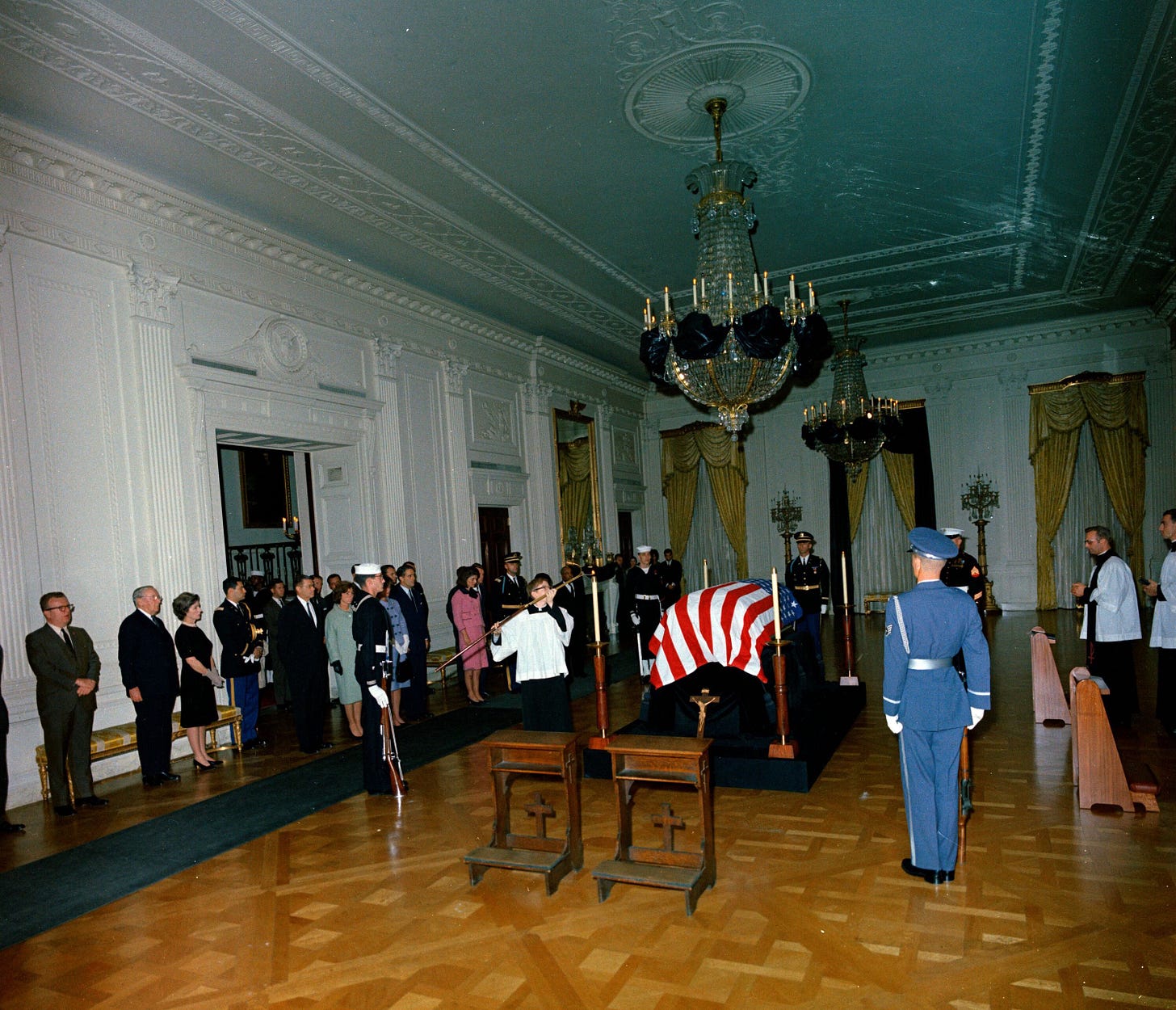
John Adams inscription
One moment in the program resonates particularly strongly today. Charles Collingwood mentions the inscription on the fireplace in the State Dining Room, calling it “one of the most moving things in the White House.” The inscription was placed there at the suggestion of President Franklin D. Roosevelt.
Jackie Kennedy replied, “Yes. That’s from the very first letter that was ever written from the White House. It was written by John Adams, the first president to live here, to his wife Abigail when he’d only been here two days, on November 2nd, 1800.”
The inscription reads: “I pray heaven to bestow the best of blessings on this house and on all that shall hereafter inhabit it.
“May none but honest and wise men ever rule under this roof.”
(For more, watch the tour of the White House here.)



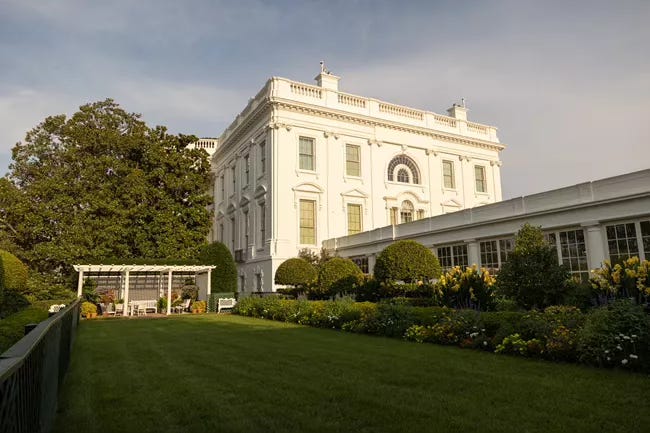
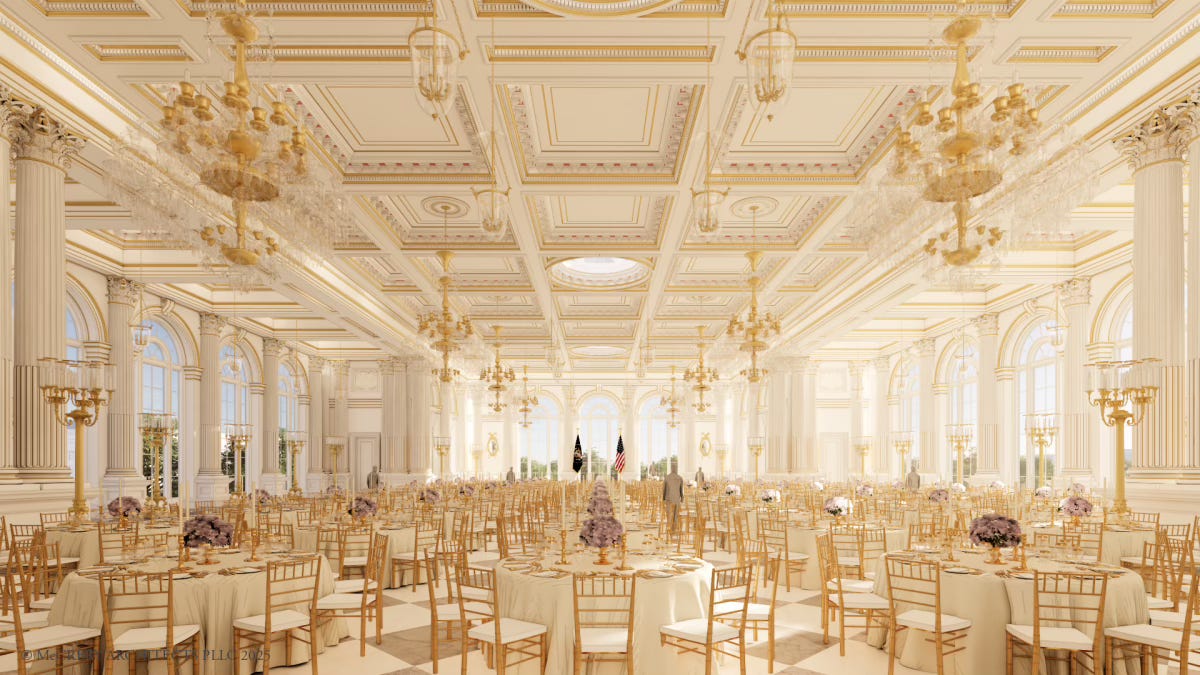
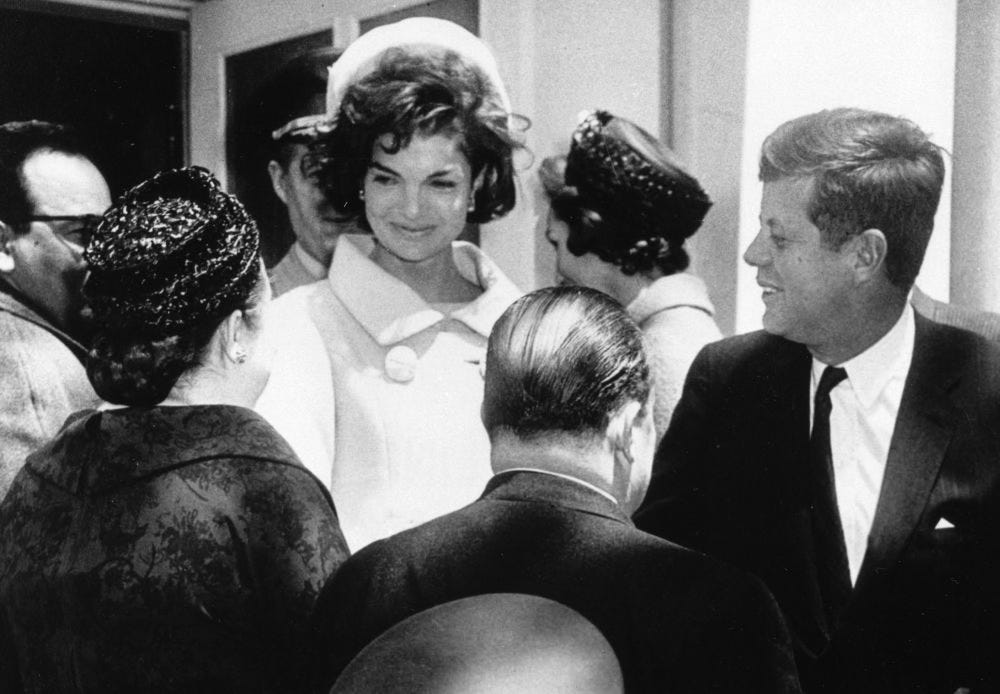
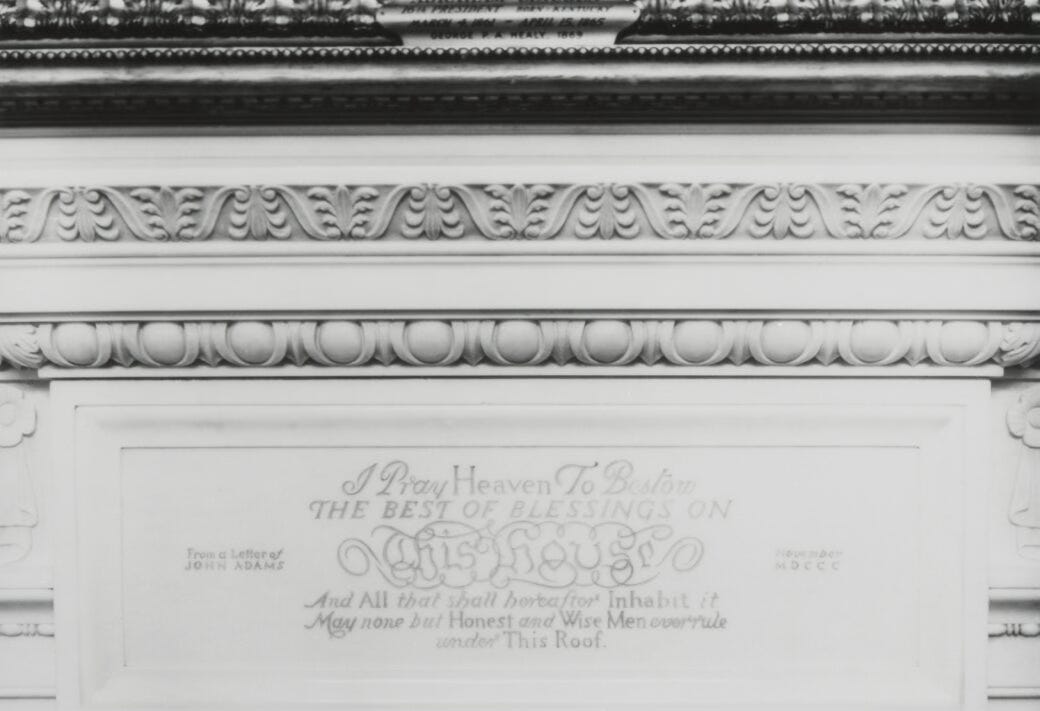
Great to learn T Jefferson anonymously entered design competition -- and lost. In this case, wonder if Don Jr. entered incognito only to be edged out by Eric. Thanks again for hard work and surprising info.